-- The United States topped the world's COVID-19 cases while some U.S. politicians have kept scapegoating China.
-- Being the first to report the virus does not mean that Wuhan is its origin. Calling the virus "Wuhan virus" or "Chinese virus" is nothing but stigmatization.
-- China has provided timely information to the world, including the WHO, in an open, transparent and responsible manner.
-- With stringent measures, the number of infections in China was reduced by more than 700,000 and very few cases were exported from China.
-- China's assistance to other countries is a return of their kindness in helping China with the COVID-19 response.
by Xinhua writer Wang Zhuolun
BEIJING, May 10 (Xinhua) -- Confirmed cases of COVID-19 in the United States have exceeded 1.3 million with death toll surpassing 78,000. Instead of concentrating on fighting against the pandemic domestically, some U.S. politicians recently have been fabricating preposterous allegations and pinning the blame on China, to hide their irresponsibility at home.
"You can fool all the people some of the time, and some of the people all the time, but you cannot fool all the people all the time," said Abraham Lincoln.
Lies evaporate in the light of truth, and let's see how facts speak for themselves.
WUHAN ORIGINATED?
Not necessarily. The place that first reported a virus was often not its origin. Increasing evidence proves that the Spanish Flu did not originate from Spain.
On Feb. 11 this year, the World Health Organization (WHO) officially named the pneumonia caused by novel coronavirus the Coronavirus Disease 2019 (COVID-19) on the basis of the 2015 Best Practices for the Naming of New Human Infectious Diseases, in which it is clearly stipulated that the naming of a disease should not be associated with a particular country or place.
The origin of COVID-19 is still not identified. Source tracing is a serious scientific matter, which should be based on science and should be studied by scientists and medical experts. Being the first to report the virus does not mean that Wuhan is its origin.
Therefore, calling the virus "Wuhan virus" or "Chinese virus" is nothing but stigmatization.
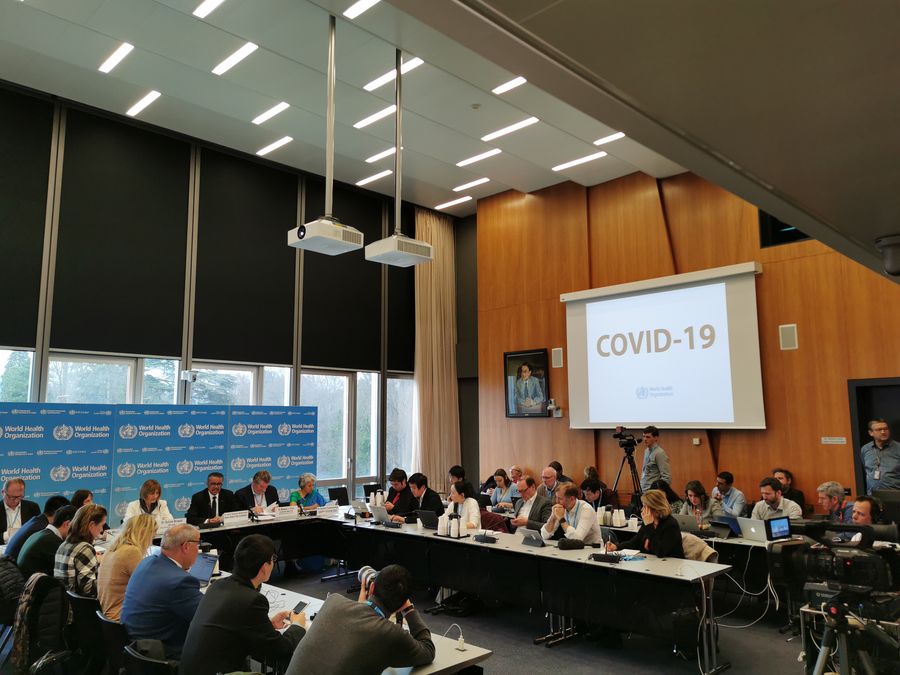
The WHO on Feb. 11 2020 gave the official name for the latest novel coronavirus as being COVID-19, which stands for coronavirus disease starting in 2019. (Xinhua/Chen Junxia)
Abundant evidence also shows cases outside China were earlier than deemed. USA Today reported on May 6 that 171 people in Florida showed symptoms of COVID-19 as early as in January, and none reported traveling to China. Michael Melham, mayor of Belleville of New Jersey, said he has tested positive for coronavirus antibodies, and thinks he may have been sick with the virus back in November last year, over two months before the first reported case in the country on Jan. 20.
Mainstream western media including the New York Times, the American Broadcasting Company (ABC) and the British Broadcasting Corporation (BBC) all reported that the wrongful connection of Asian communities with COVID-19 stoked serious xenophobia, and frequent occurrences of racist discrimination and harassment against these communities in the United States.
Viruses are the common enemy of mankind, which may appear at any time and in any place. WHO and scientists worldwide have fiercely rebutted the allegation made by some U.S. politicians that the virus was constructed and leaked by the Wuhan Institute of Virology.
Saying on April 21 that all available evidence suggests the virus has an animal origin and is "not manipulated or constructed in a lab or somewhere else," WHO spokesperson Fadela Chaib stressed it most likely has its ecological reservoir in bats but how the virus came from bats to humans is still to be seen and discovered.
A joint statement published on Feb. 19 by the Lancet, a prestigious UK medical journal, overwhelmingly concluded that COVID-19 originated in wildlife, as have so many other emerging pathogens.
"If you look at the evolution of the virus in bats and what's out there now, (the scientific evidence) is very, very strongly leaning toward this could not have been artificially or deliberately manipulated..." Anthony Fauci, director of the U.S. National Institute of Allergy and Infectious Diseases, told National Geographic in an interview published on May 4.
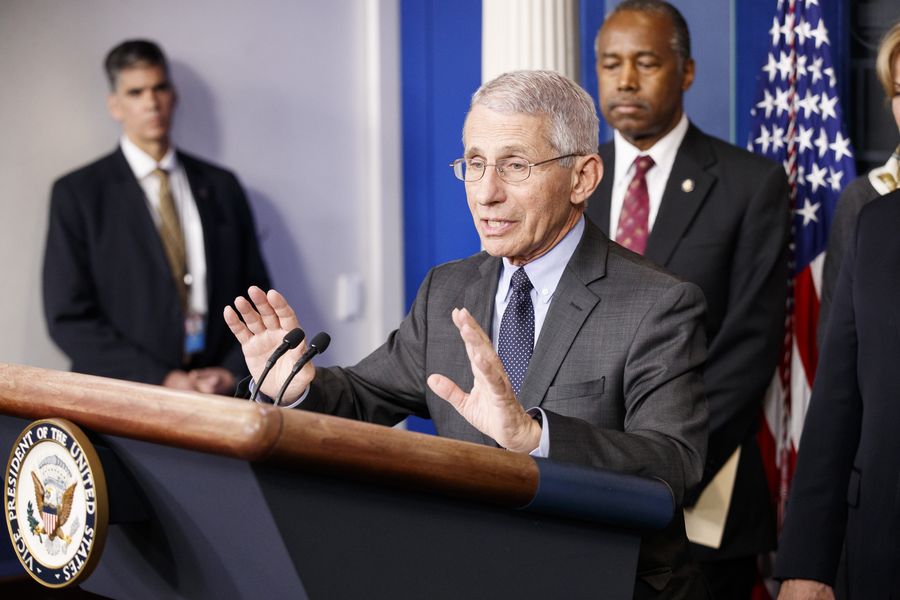
Anthony Fauci speaks during a press conference on the coronavirus at the White House in Washington D.C., the United States, March 4, 2020. (Photo by Ting Shen/Xinhua)
COVER UP?
It takes time to study and understand an unexpected attack by an unknown virus against human beings. China has provided timely information to the world in an open, transparent and responsible manner.
On Dec. 27, 2019, three cases of pneumonia of unknown cause were immediately reported by Zhang Jixian, a doctor in Wuhan, after she received the patients, the first reporting of suspected cases of a new disease by local authorities of China. On the same day, epidemiological investigation and testing on the patients concerned was conducted by the Wuhan Center for Disease Control and Prevention.
The next few days witnessed two emergency notices and a situation report released by the Wuhan authorities. On Dec. 31, China informed the WHO China Country Office of cases of pneumonia of unknown cause detected in Wuhan. On Jan. 3, 2020, China began sending regular, timely updates about the novel coronavirus to the WHO, and other countries including the United States.
Following the first public reporting of the pneumonia by the Wuhan Municipal Health Commission on Dec. 31, China completed the identification and sequencing of the virus as early as on Jan. 7, and shared the genome sequence information with WHO and other countries on Jan. 11.
On Jan. 20, the high-level expert group of the National Health Commission informed the media that the novel coronavirus could be transmitted from person to person. On Jan. 22, the WHO issued a warning about the potential risk of human-to-human transmission on its website, and eight days later, it declared the outbreak a Public Health Emergency of International Concern (PHEIC).
"The WHO has been in constant technical communication with China since Jan. 3 on the severity, transmission dynamics and the possibility of sustained human-to-human transmission, the clinical course, and effectiveness of treatments, and the WHO has provided detailed information to the international community under the framework of the International Health Regulations (IHR)," said Dr. Gauden Galea, WHO representative in China.
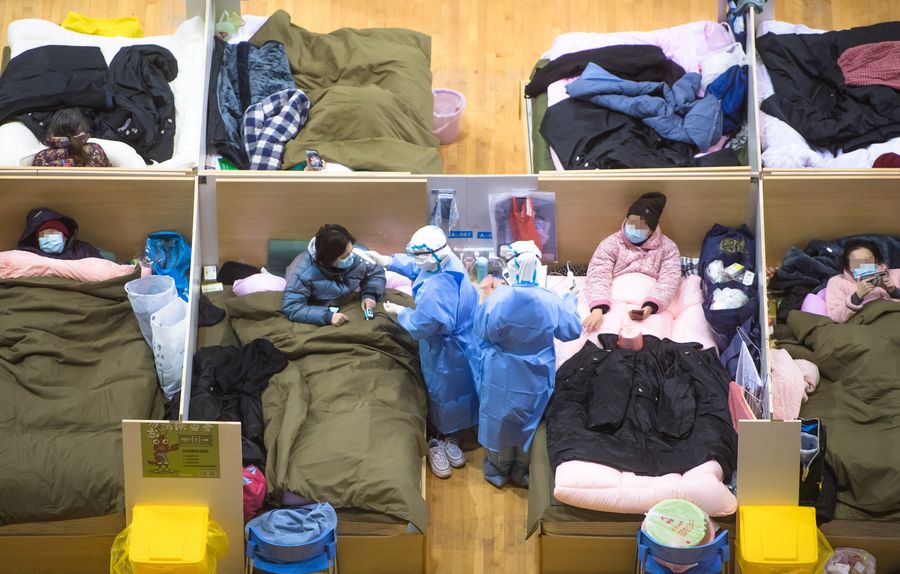
Medical staff members from Jiangsu Province examine patients at the temporary hospital converted from Wuhan Sports Center in Wuhan, Feb. 17, 2020. (Xinhua/Xiao Yijiu)
China's transparency in data releasing has been consistent. On April 17, Wuhan issued a notification revising up confirmed cases by 325 to a total of 50,333, and fatal cases by 1,290 to a total of 3,869.
Revision is by no means equal to covering-up. On the contrary, it was out of a high sense of responsibility to the people and to the lives lost to the coronavirus that Wuhan took the initiative to revise the numbers. When the city was first hit by the virus, hospitals were running overloaded and some patients passed away at home, and there were missed, delayed, inadequate or inaccurate reporting of cases.
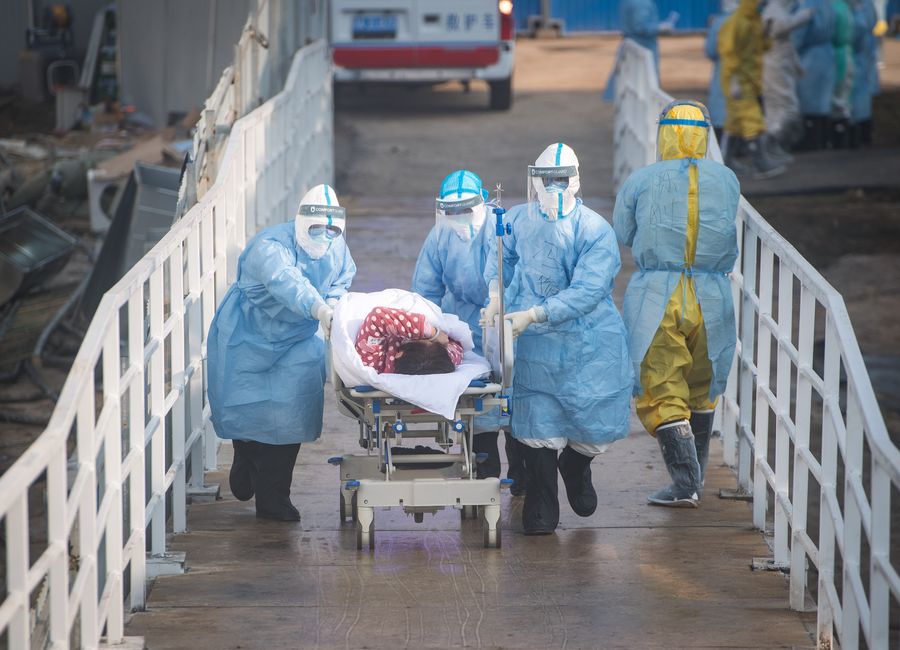
Medical workers help the first batch of patients infected with the novel coronavirus move into their isolation wards at Huoshenshan Hospital in Wuhan, Feb. 4, 2020. (Xinhua/Xiao Yijiu)
On April 28, Christoffer Koch and Ken Okamura, two economists from the United States and the United Kingdom, jointly published a paper based on studies of the data from China, Italy and the United States. They found that the confirmed infections in China match the distribution expected in Benford's Law and are similar to those in the other two countries, concluding that there is no possibility of manipulation of figures.
EXPORT CASES?
With the most comprehensive, rigorous and thorough measures taken by the Chinese government within the shortest possible time, the number of infections in China was reduced by more than 700,000.
Having effectively broken the chain of transmission domestically, it is no surprise that very few cases were exported from China, the country with the largest populations and where COVID-19 cases were earliest found.
Wuhan, the earliest epicenter of COVID-19, was put under lockdown between Jan. 23 and April 8. So it was impossible for Wuhan residents to travel overseas during this period of time.
Two days after Wuhan was put under lockdown, 30 provinces, autonomous regions and municipalities of China activated the highest-level disease response. Starting from Jan. 24, 42,000 medical workers from across the country rallying in over 330 medical teams set out to the front line in Hubei Province.
With massive human and material resources being polled in, two makeshift hospitals, accommodating 1,000 and 1,600 beds respectively, were constructed in 10 and 15 days. Meanwhile, a total of 16 mobile hospitals were put in place to accommodate over 13,000 patients.

People work at the construction site of Leishenshan Hospital in Wuhan, Feb. 4, 2020. (Xinhua/Xiao Yijiu)
In Wuhan, over 44,500 primary-level Party officials were sent to 13,800 residential communities, building up a strong line of defense against the virus. Social distancing measures have been supported and strictly observed nationwide, effectively curbing the spread of the virus.
Regarding the suspected cases and close contacts, they have been placed under quarantine at designated places to stem further spread of the virus.
The high speed and massive scale of China's response have been rarely seen in the world, demonstrating China's speed, scale and efficiency, said WHO Director-General Tedros Adhanom Ghebreyesus, adding that China's experience is worth learning for other countries.
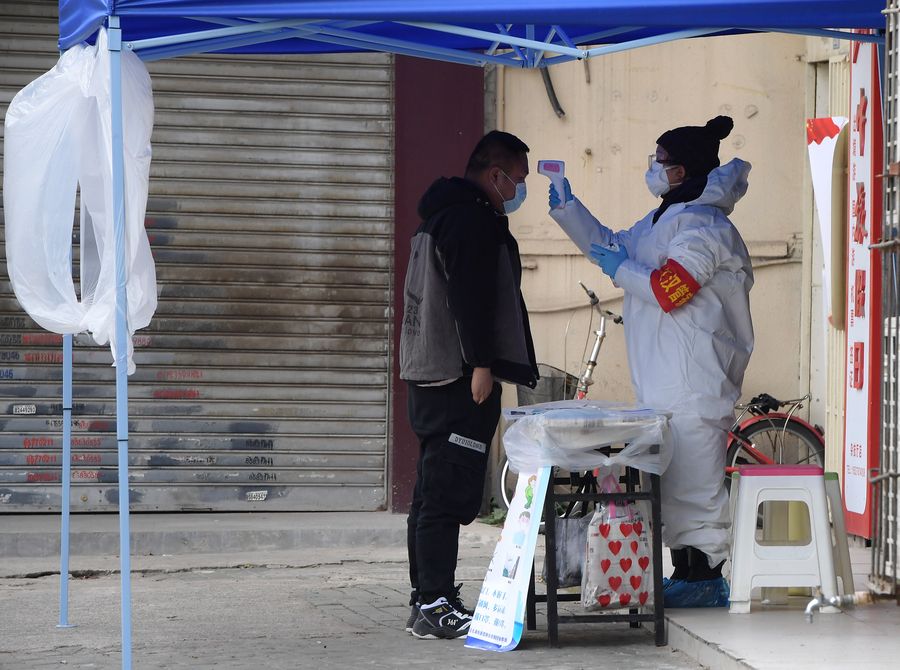
A staff member from Wuhan government department who works as a community inspector, measures a visitor's temperature at the entrance of a residential block in Wuhan, Feb. 10, 2020. (Xinhua/Li He)
This explains why China's nationwide infection rate has stayed relatively low and refutes the claim that "China spreads the virus to the rest of the world."
-- In the United States, the New York Times cited U.S. research that most New York coronavirus cases did not come from Asia.
-- In Canada, data from its major provinces show that the virus was brought into the country by U.S. visitors.
-- In France, research found that the virus strain circulating locally is of unknown origin.
-- In Singapore, cases imported from China were less than one-tenth of those from other countries.
-- In Japan, researchers believed that the strain confirmed in the country since early March was not from China.
-- In Russia, none of the imported cases was from China.
CONTROL THE WHO?
Amid increasing severe pandemic situations around the globe, the U.S. decision to halt its funding to the WHO has drawn sharp criticism. Saying the WHO "failed to adequately obtain, vet and share information in a timely and transparent fashion," some U.S. politicians alleged China is "manipulating" and "bribing" the organization.
This accusation is absurd. As a firm supporter to multilateralism, China has all along been in good communication and cooperation with the WHO, a specialized UN agency responsible for public health security composed of 194 member states.
Among the 21-strong headquarters leadership team of the WHO, 11 are from the United States, the European Union, Canada and Australia, and only one is from China. They are all trained or practicing doctors, epidemiologists, rescue workers and public health experts.
In 2018 and 2019, China was the third biggest donor to WHO's assessed contributions, after the United States and Japan. According to the WHO, assessed contributions only account for less than a quarter of its total funding, with the rest being voluntary contributions. With both sources of funding counted, China is the ninth biggest contributor.
Isn't it too easy for the WHO to be "manipulated" by a single country?
Accusations that China has "blocked Taiwan's bid to join the WHO and put the health of the people there at risk" is also groundless. Taiwan, being part of China, has no right to join the WHO, whose membership requires sovereign statehood.
Since the start of COVID-19, China's National Health Commission has provided timely information to the Taiwan region. As of May 6, China's mainland had updated Taiwan on the situation 148 times. In mid-January, the mainland arranged a field visit to Wuhan for experts from Taiwan to help them learn more about the diagnosis and treatment of confirmed cases and COVID-19 response measures.
SELF-SERVING HELP?
A friend in need is a friend indeed. China has been doing its utmost to help countries in need.
However, China's sincere efforts were distorted by some U.S. politicians as to serve "political and propaganda purposes."
As of mid-May, China has set up 2-billion-yuan fund for COVID-19 cooperation. China has provided anti-epidemic supplies to more than 150 countries and international organizations, shared experience on prevention, control, diagnosis and treatment with the rest of the international community, established online knowledge center on epidemic prevention and control that is open to all countries, held over 120 video conferences with more than 160 countries and international organizations, and sent 21 teams of medical experts to 19 countries.
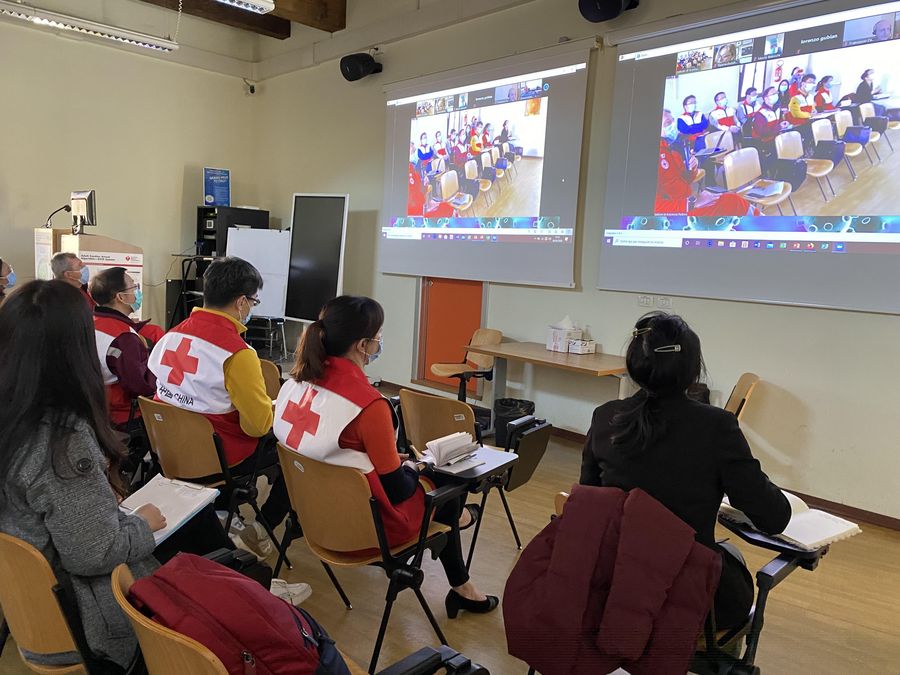
Chinese medical experts discuss with members of academic committee and epidemiologists from Veneto via internet in Padova, Italy, March 18, 2020. (China's Anti-Epidemic Expert Team/Handout via Xinhua)
According to the Ministry of Commerce of China, between March 1 and May 6, China has met export orders for anti-epidemic supplies from 194 countries and regions. Among them, 77 countries and regions as well as six international organizations have signed commercial procurement agreements with China through official channels for 216 shipments of medical supplies.
Besides donating 50 million U.S. dollars in cash to the WHO, China has agreed to suspend principal and interest repayment for 77 developing countries' debts due between May 1 and the end of 2020, in response to the debt service suspension initiative for the poorest countries adopted at a recent G20 meeting.
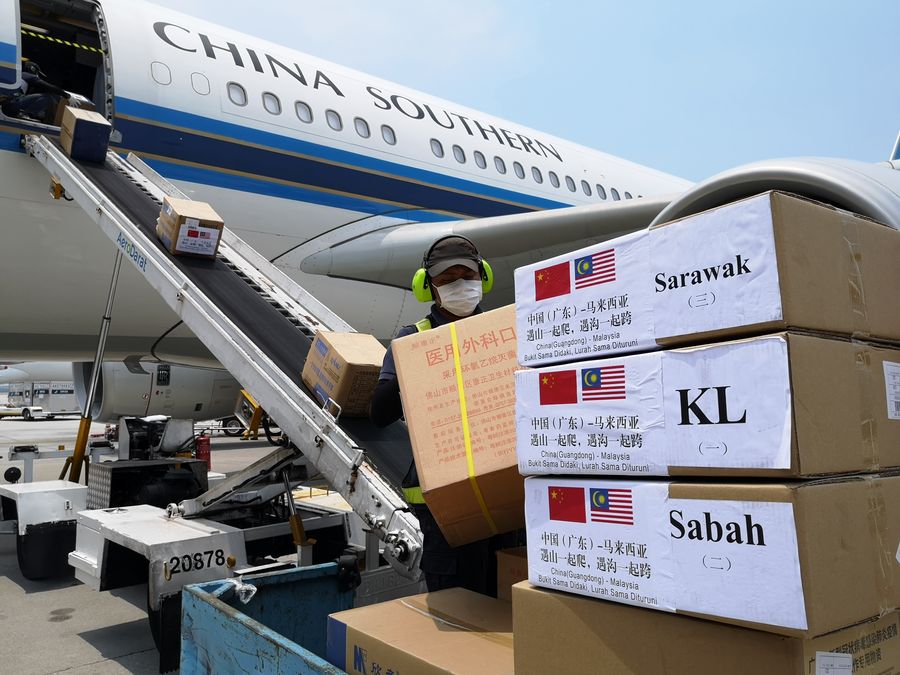
A worker unloads medical supplies brought by an anti-COVID-19 medical team from China to Malaysia at Kuala Lumpur International Airport in Sepang, Selangor, Malaysia, April 18, 2020. (Chinese Embassy in Malaysia/Handout via Xinhua)
China's assistance to other countries is a return of their kindness in helping China with the COVID-19 response. The actions of support and assistance have been widely recognized by the international community. It is also a concrete step to put into action the vision of building a community with a shared future for humanity. ■



